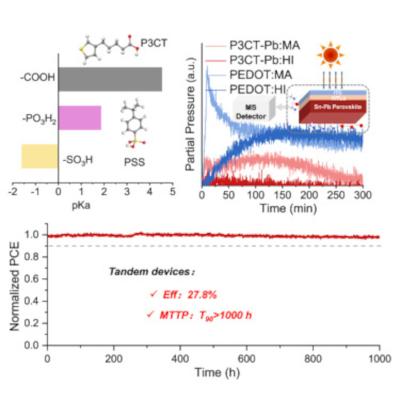Researchers at The University of Toledo (UToledo), Northwestern University and University of Washington have focused on the stability of perovskite solar cells, and reported an adjustment to the chemical structure of a key component of a tandem cell that allows it to continuously generate electricity for more than 1,000 hours.
Image from Joule
“State-of-the-art all-perovskite tandem cells with a conventional hole-transfer layer can only continuously operate for hundreds of hours,” said Dr. Zhaoning Song, a co-author and assistant professor in the Department of Physics and Astronomy at UToledo. “Our innovation prolongs the stability of these devices, advancing all-perovskite tandem technology and bringing it closer to practical application.”
The hole-transfer layer is an important component of a solar cell, which in its simplest form consists of two stacked semiconductors that generate electricity through a complex shift of electrons. The hole-transfer layer, which collects positively charged particles called “holes,” is integral to the efficiency of this electron-shifting process.
Researchers have long noticed a complication related to the hole-transfer layers of low-band-gap tin-lead perovskites — namely, the conventional hole-transfer layer reacts chemically with the semiconductor in this case, corroding the panel and hindering its stability. This is significant because low-band-gap tin-lead perovskites are an essential component of an all-perovskite tandem solar cell. All-perovskite tandem solar cells incorporate a wide-band-gap top cell and low-band-gap bottom cell, drawing on a different part of the sun’s spectrum to generate electricity.
In their recent research, the team identified the source of the corrosion in the low-band-gap cells and introduce nonconventional hole-transfer layer with a caroboxyl group with a higher acid disassociation constant. This new hole-transfer layer suppresses the deprotonation process that causes the corrosion and ultimately extends the lifespan of the tandem unit to more than 1,000 hours with an efficiency loss of less than 3%.
The team fabricated all-perovskite tandem solar cells with a champion efficiency of 27.8% and an operational lifetime of over 1,000 h, with 97% retaining efficiency under maximum power point tracking.
“UToledo physicists are committed to advancing perovskite solar cell technology, which we believe promises to be a lower-cost, higher-efficiency alternative to silicon as we look toward a decarbonized future,” said Dr. Yanfa Yan, senior author and a Distinguished University Professor in the Department of Physics and Astronomy. “This is an exciting development, but there are still obstacles to overcome before all-perovskite tandem solar cells make it to the commercial market.”




